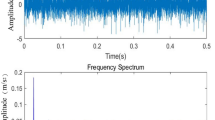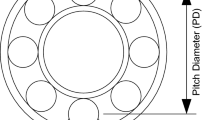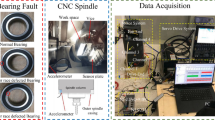Abstract
Purpose
To address challenges in Intelligent Fault Diagnosis (IFD) of bearings in rotating machinery, this study aims to propose a model that reduces computational resources and expert dependence while enhancing performance under diverse operating conditions.
Method
The study introduces the Segmentation-based Augmented Cosine K—nearest neighbors (SACK) model, integrating raw vibration signal segmentation and data augmentation techniques. Unlike traditional approaches, SACK eliminates frequency or time-frequency signal processing, simplifying augmentation using existing tools.
Result
Evaluation of the SACK model reveals satisfactory performance and improvements compared to other Machine Learning (ML) models. Enhanced robustness across various operating conditions suggests potential efficiency gains in computational resources and reduced reliance on human experts. The proposed model presents a promising solution for cost-effective IFD implementation in resource-constrained environments.












Similar content being viewed by others
References
Anwarsha A, Babu TN (2022) Recent advancements of signal processing and artificial intelligence in the fault detection of rolling element bearings: a review. J Vibroengineering 24(6):1027–1055. https://doi.org/10.21595/jve.2022.22366
Zhang S, Zhang S, Wang B, Habetler TG (2019) Machine learning and deep learning algorithms for bearing fault diagnostics—a comprehensive review. IEEE Access. https://doi.org/10.1109/ACCESS.2020.2972859
Iqbal M, Madan AK (2023) Machine learning based faulty bearing diagnosis in CNC machine. Available: http://www.ijeast.com. Accessed 1 Feb 2024
Mohiuddin M, Islam MS (2022) Rolling element bearing faults detection and classification technique using vibration signals †. Eng Proc. https://doi.org/10.3390/ecsa-9-13339
Saufi SR, Bin Ahmad ZA, Leong MS, Lim MH (2019) Challenges and opportunities of deep learning models for machinery fault detection and diagnosis: a review. IEEE Access Inst Electr Electron Eng Inc. https://doi.org/10.1109/ACCESS.2019.2938227
Zhang S, Zhang S, Wang B, Habetler TG (2020) Deep learning algorithms for bearing fault diagnosticsx—a comprehensive review. IEEE Access Inst Electr Electron Eng Inc 8:29857–29881
Hakim M, Omran AAB, Ahmed AN, Al-Waily M, Abdellatif A (2023) A systematic review of rolling bearing fault diagnoses based on deep learning and transfer learning: taxonomy, overview, application, open challenges, weaknesses and recommendations. Ain Shams Eng J. https://doi.org/10.1016/j.asej.2022.101945
Saufi SR, Isham MF, Ahmad ZA, Hasan MDA (2023) Machinery fault diagnosis based on a modified hybrid deep sparse autoencoder using a raw vibration time-series signal. J Ambient Intell Humaniz Comput 14(4):3827–3838. https://doi.org/10.1007/s12652-022-04436-1
Iqbal M, Madan AK (2022) CNC Machine-bearing fault detection based on convolutional neural network using vibration and acoustic signal. J Vib Eng Technol 10(5):1613–1621. https://doi.org/10.1007/s42417-022-00468-1
Sahu PK, Rai RN (2023) Effect of time-frequency representations for fault classification of rolling bearing in noisy conditions using deep learning. In: 2023 25th International Conference on Digital Signal Processing and its Applications, DSPA 2023, Institute of Electrical and Electronics Engineers Inc. https://doi.org/10.1109/DSPA57594.2023.10113425.
Iqbal M, Madan AK (2023) Bearing fault diagnosis in CNC machine using hybrid signal decomposition and gentle AdaBoost learning. J Vib Eng Technol. https://doi.org/10.1007/s42417-023-00930-8
Lu Q, Shen X, Wang X, Li M, Li J, Zhang M (2021) Fault diagnosis of rolling bearing based on improved VMD and KNN. Math Probl Eng. https://doi.org/10.1155/2021/2530315
Wang Z, Xia H, Zhang J, Yang B, Yin W (2023) Imbalanced sample fault diagnosis method for rotating machinery in nuclear power plants based on deep convolutional conditional generative adversarial network. Nucl Eng Technol 55(6):2096–2106. https://doi.org/10.1016/j.net.2023.02.036
Lyu P, Zhang H, Yu W, Liu C (2022) A novel model-independent data augmentation method for fault diagnosis in smart manufacturing. Procedia CIRP. Elsevier B.V., pp 949–954
Zhang T, He S, Chen J, Pan T, Zhou Z (2022) Toward small sample challenge in intelligent fault diagnosis: attention-weighted multidepth feature fusion net with signals augmentation. IEEE Trans Instrum Meas. https://doi.org/10.1109/TIM.2021.3134999
Tnani MA, Subarnaduti P, Diepold K (2022) Efficient feature learning approach for raw industrial vibration data using two-stage learning framework. Sensors. https://doi.org/10.3390/s22134813
Gawde S, Patil S, Kumar S, Kotecha K (2023) A scoping review on multi-fault diagnosis of industrial rotating machines using multi-sensor data fusion. Artif Intell Rev 56(5):4711–4764. https://doi.org/10.1007/s10462-022-10243-z
Singh V, Gangsar P, Porwal R, Atulkar A (2023) Artificial intelligence application in fault diagnostics of rotating industrial machines: a state-of-the-art review. J Intelligent Manufacturing Springer. https://doi.org/10.1007/s10845-021-01861-5
Liang YL, Chien W, Yuan SF (2023) Overview of bearing fault diagnosis based on vibration signal. In: 2023 IEEE 3rd International Conference on Electronic Communications, Internet of Things and Big Data, ICEIB 2023, Institute of Electrical and Electronics Engineers Inc, pp 547–549
Hakim M et al (2022) Bearing fault diagnosis using lightweight and robust one-dimensional convolution neural network in the frequency domain. Sensors. https://doi.org/10.3390/s22155793
Dan Y, Hongbing J, Yongchan G (2019) A robust D-S fusion algorithm for multi-target multi-sensor with higher reliability. Information Fusion 47:32–44. https://doi.org/10.1016/j.inffus.2018.06.009
Zhang A, Li S, Cui Y, Yang W, Dong R, Hu J (2019) Limited data rolling bearing fault diagnosis with few-shot learning. IEEE Access 7:110895–110904. https://doi.org/10.1109/ACCESS.2019.2934233
Kang Y, Chen G, Pan W, Wei X, Wang H, He Z (2023) A dual-experience pool deep reinforcement learning method and its application in fault diagnosis of rolling bearing with unbalanced data. J Mech Sci Technol 37(6):2715–2726. https://doi.org/10.1007/s12206-023-0501-y
Weng C, Lu B, Gu Q, Zhao X (2023) A novel hierarchical transferable network for rolling bearing fault diagnosis under variable working conditions. Nonlinear Dyn 111(12):11315–11334. https://doi.org/10.1007/s11071-023-08405-x
Liu X, Zhao X, He K (2022) Feasibility study of the GST-SVD in extracting the fault feature of rolling bearing under variable conditions. Chin J Mech Eng (English Edition). https://doi.org/10.1186/s10033-022-00806-0
Yang B, Sun H (2023) A zero-shot learning fault diagnosis method of rolling bearing based on extended semantic information under unknown conditions. J Braz Soc Mech Sci Eng. https://doi.org/10.1007/s40430-022-03965-2
Zhang R, Gu Y (2022) A transfer learning framework with a one-dimensional deep subdomain adaptation network for bearing fault diagnosis under different working conditions. Sensors. https://doi.org/10.3390/s22041624
Yang J, Liu J, Xie J, Wang C, Ding T (2021) Conditional GAN and 2-D CNN for bearing fault diagnosis with small samples. IEEE Trans Instrum Meas. https://doi.org/10.1109/TIM.2021.3119135
Maguolo G, Paci M, Nanni L, Bonan L (2021) Audiogmenter: a MATLAB toolbox for audio data augmentation. Appl Comput Informatics. https://doi.org/10.1108/ACI-03-2021-0064
Saghi T, Bustan D, Aphale SS (2023) Bearing fault diagnosis based on multi-scale CNN and Bidirectional GRU. Vibration 6(1):11–28. https://doi.org/10.3390/vibration6010002
Han S, Oh S, Jeong J (2021) Bearing fault diagnosis based on multiscale convolutional neural network using data augmentation. J Sens. https://doi.org/10.1155/2021/6699637
Oh JW, Jeong J (2020) Data augmentation for bearing fault detection with a light weight CNN. Procedia computer science. Elsevier BV, pp 72–79
Lopez-Bernal D, Balderas D, Ponce P, Molina A (2021) Education 40: Teaching the basics of knn, lda and simple perceptron algorithms for binary classification problems. Future Internet. https://doi.org/10.3390/fi13080193
Neupane D, Seok J (2020) Bearing fault detection and diagnosis using case western reserve university dataset with deep learning approaches: a review. IEEE Access Inst Electr Electron Eng Inc 8:93155–93178. https://doi.org/10.1109/ACCESS.2020.2990528
Saufi SR, Bin Ahmad ZA, Leong MS, Lim MH (2019) Low-speed bearing fault diagnosis based on ArSSAE model using acoustic emission and vibration signals. IEEE Access 7:46885–46897. https://doi.org/10.1109/ACCESS.2019.2909756
Smith WA, Randall RB (2015) Rolling element bearing diagnostics using the Case Western Reserve University data: a benchmark study. Mech Syst Signal Process 6465:100–131. https://doi.org/10.1016/j.ymssp.2015.04.021
Fu L, Cheng L, Chen W, Cai X (2023) Bearing fault diagnosis with small sample based on data-driven. In: Institute of Electrical and Electronics Engineers (IEEE), Nanjing, China, pp 369–373
Liu B, Yan C, Wang Z, Liu Y, Wu L (2023) Fault diagnosis of rolling bearing under limited samples using joint learning network based on local-global feature perception. J Mech Sci Technol. https://doi.org/10.1007/s12206-023-0607-2
Senthamil Selvi M, Jansi Rani S (2021) Classification of admission data using classification learner toolbox. J Phys Conf Ser. https://doi.org/10.1088/1742-6596/1979/1/012043
Acknowledgements
The authors would like to extend their greatest gratitude to the Institute of Noise and vibration UTM for funding the current study under the Higher Institution Centre of Excellence (HICoE) Grant Scheme of Advanced Health Monitoring for Turbomachinery (R.K130000.7843.4J227) and Health Monitoring and Integrity Assessment of Ageing Assets (R.K130000.7843.4J228).
Author information
Authors and Affiliations
Corresponding author
Additional information
Publisher's Note
Springer Nature remains neutral with regard to jurisdictional claims in published maps and institutional affiliations.
Rights and permissions
Springer Nature or its licensor (e.g. a society or other partner) holds exclusive rights to this article under a publishing agreement with the author(s) or other rightsholder(s); author self-archiving of the accepted manuscript version of this article is solely governed by the terms of such publishing agreement and applicable law.
About this article
Cite this article
Yap, J.S., Lim, M.H. & Leong, M.S. Incorporating Segmentive & Augmentive Tools in Cosine KNN for Bearing Intelligent Fault Diagnosis. J. Vib. Eng. Technol. (2024). https://doi.org/10.1007/s42417-024-01377-1
Received:
Revised:
Accepted:
Published:
DOI: https://doi.org/10.1007/s42417-024-01377-1




